gas type PONTIAC BONNEVILLE 1994 Owners Manual
[x] Cancel search | Manufacturer: PONTIAC, Model Year: 1994, Model line: BONNEVILLE, Model: PONTIAC BONNEVILLE 1994Pages: 290, PDF Size: 14.75 MB
Page 24 of 290
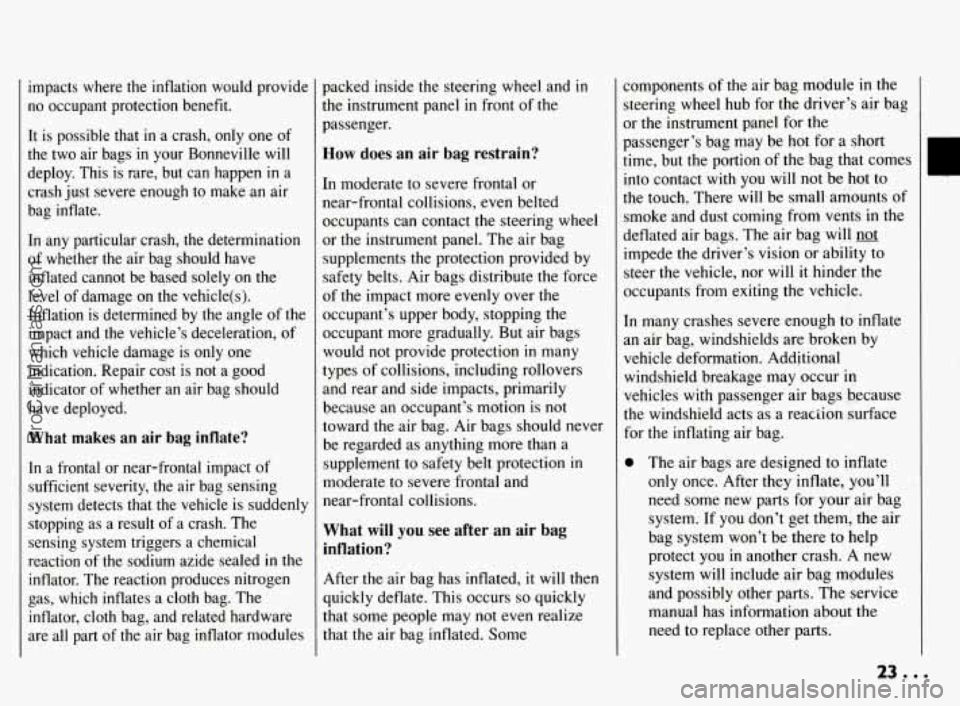
impacts where the inflation would provide
no occupant protection benefit.
It is possible that
in a crash, only one of
the two air bags in your Bonneville will
deploy. This is rare, but can happen
in a
crash just severe enough to make an air
bag inflate.
In any particular crash, the determination
of whether the air bag should have
inflated cannot be based solely on the
level
of damage on the vehicle(s).
Inflation is determined by the angle of the
impact and the vehicle’s deceleration, of
which vehicle damage is only one
indication. Repair cost is not a good
indicator of whether an air bag should
have deployed.
What makes an air bag inflate?
In a frontal or near-frontal impact of
sufficient severity, the air bag sensing
system detects that the vehicle
is suddenly
stopping as a result of a crash. The
sensing system triggers a chemical
reaction of the sodium azide sealed in the
inflator. The reaction produces nitrogen
gas, which inflates a cloth bag. The
inflator, cloth bag, and related hardware
are all part of the air bag inflator modules packed
inside the steering wheel and
in
the instrument panel in front of the
passenger.
How does an air bag restrain?
In moderate to severe frontal or
near-frontal collisions, even belted
occupants can contact the steering wheel or the instrument panel. The air bag
supplements the protection provided by
safety belts. Air bags distribute the force
of the impact more evenly over the
occupant’s upper body, stopping the
occupant more gradually. But air bags
would not provide protection in many
types of collisions, including rollovers
and rear and side impacts, primarily
because an occupant’s motion is not
toward the air bag. Air bags should never
be regarded as anything more than a
supplement to safety belt protection
in
moderate to severe frontal and
near-frontal collisions.
What will you see after an air bag
inflation?
After the air bag has inflated, it will then
quickly deflate. This occurs
so quickly
that some people may not even realize
that the air bag inflated. Some components of the
air bag module in the
steering wheel hub for the driver’s air bag
or the instrument panel for the
passenger’s bag may be hot for a short
time, but the portion of the bag that comes
into contact with you will not be hot to
the touch. There will be small amounts of
smoke and dust coming from vents in the
deflated air bags. The air bag will
not
impede the driver’s vision or ability to
steer the vehicle, nor will it hinder the
occupants from exiting the vehicle.
In many crashes severe enough to inflate
an air bag, windshields are broken by
vehicle deformation. Additional
windshield breakage may occur in
vehicles with passenger air bags because
the windshield acts as a reac’lion surface
for the inflating air bag.
The air bags are designed to inflate
only once. After they inflate, you’ll
need some new parts for your air bag
system. If you don’t get them, the air
bag system won’t be there to help
protect you in anpther crash.
A new
system will include air bag modules
and possibly other parts. The service
manual has information about the
need to replace other parts.
C
23...
ProCarManuals.com
Page 199 of 290
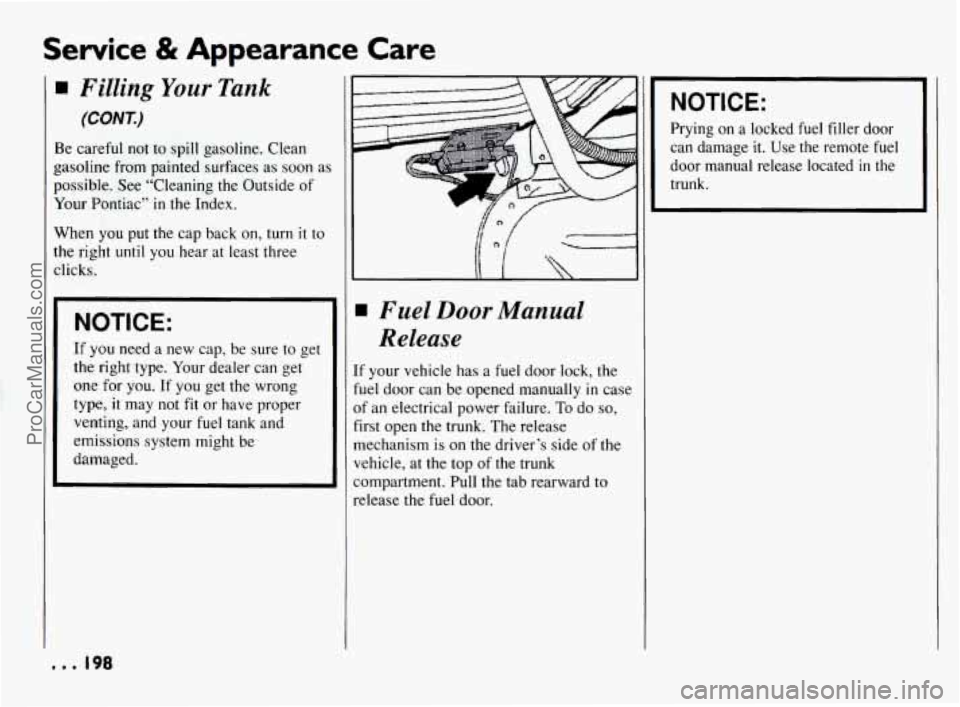
Service & Appearance Care
Filling Your Tank
(CONT)
Be careful not to spill gasoline. Clean
gasoline from painted surfaces as soon as
possible. See “Cleaning the Outside of
Your Pontiac”
in the Index.
When you
put the cap back on, turn it to
the right until you hear at least three
clicks.
L
,
NOTICE:
If you need a new cap, be sure to get
the right type. Your dealer can get
one for you. If you get the wrong
type,
it may not fit or have proper
venting, and your fuel tank and
emissions system might be
damaged.
m.. 198
IL
I
I
f
f
n
0
V
C
r(
Fuel Door Manual
Release
f your vehicle has a fuel door lock, the
uel door can be opened manually in case
If an electrical power failure. To do so,
irst open the trunk. The release
nechanism is on the driver’s side of the
,chicle, at the top of the trunk
ompartment. Pull the tab rearward to
elease the fuel door.
NOTICE:
~ ~~
Prying on a locked fuel filler door
can damage it.
Use. the remote fuel
door manual release located
in the
trunk.
ProCarManuals.com
Page 230 of 290
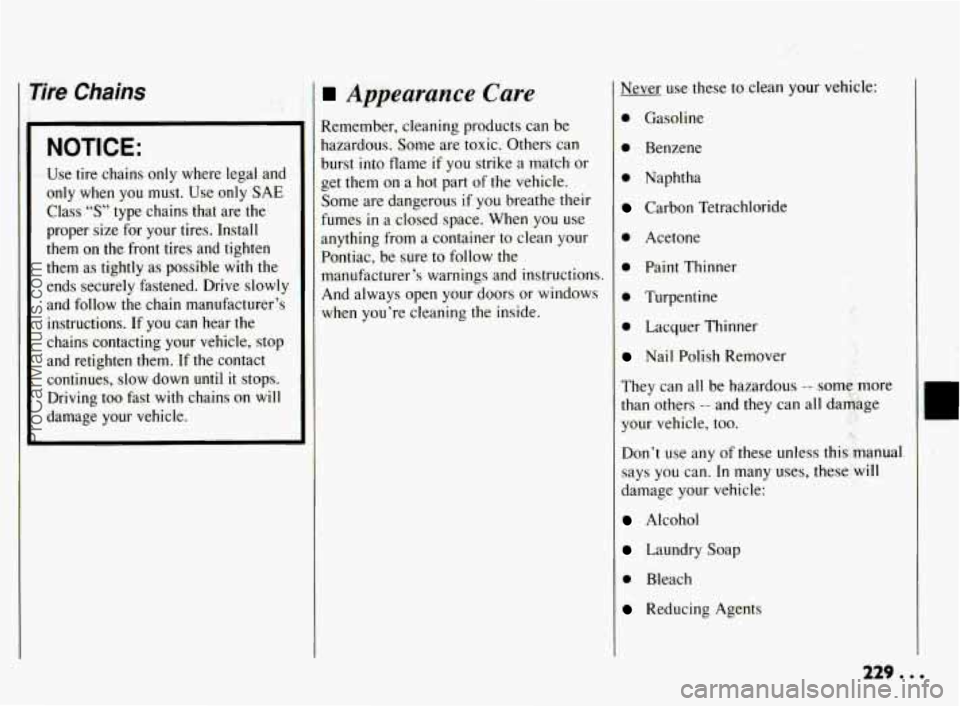
I Tire Chains
I
NOTICE:
Use tire chains only where legal and
only
when you must. Use only SAE
Class
“S” type chains that are the
proper size for your tires. Install
them on the front tires and tighten
them as tightly as possible
with the
ends securely fastened. Drive slowly
and follow the chain manufacturer’s
instructions. If you can hear
the
chains contacting your vehicle, stop
and retighten them. If the contact
continues,
slow down until it stops.
Driving too fast
with chains on will
damage your vehicle.
Appearance Care
Remember, cleaning products can be
hazardous. Some are toxic. Others can
burst into flame
if you strike a match or
get them on a hot part
of the vehicle.
Some are dangerous
if you breathe their
fumes
in a closed space. When you use
anything from a container to clean your
Pontiac, be sure to follow the
manufacturer’s warnings and instructions.
And always open your doors or windows
when you’re cleaning the inside. Never use
these to clean your vehicle:
0 Gasoline
0 Benzene
0 Naphtha
Carbon Tetrachloride
0 Acetone
0 Paint Thinner
0 Turpentine
0 Lacquer Thinner
Nail Polish Remover
They can all be hazardous
-- some more
than others
-- and they can all damage
your vehicle, too.
Don’t use any of these unless this manual
says you can. In many uses, these will
damage your vehicle:
Alcohol
Laundry Soap
0 Bleach
Reducing Agents
229 l
ProCarManuals.com
Page 256 of 290
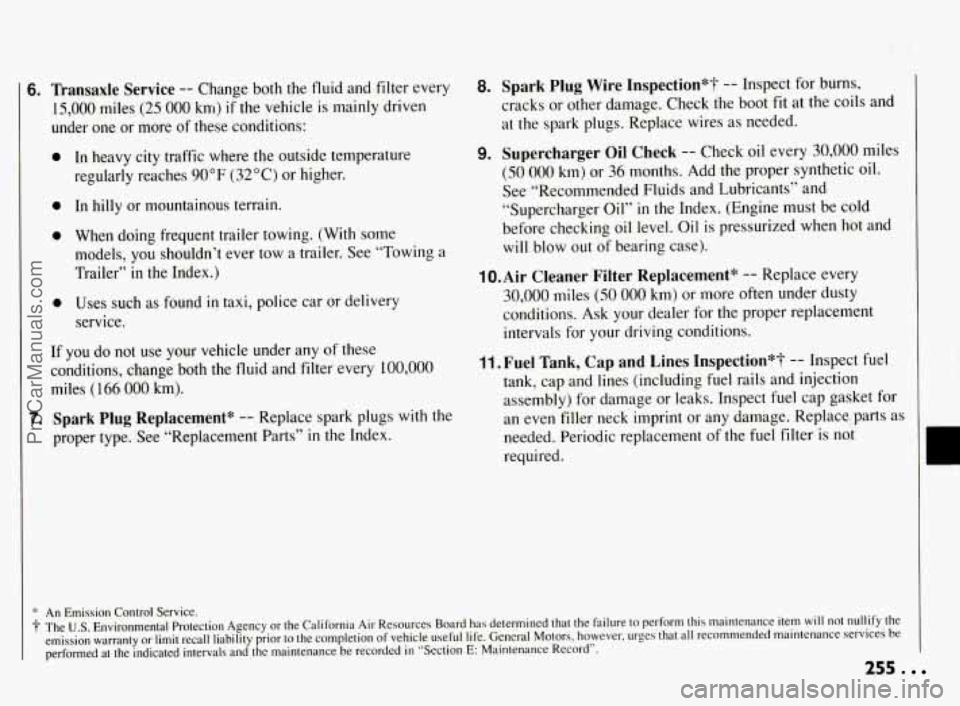
6. Transaxle Service -- Change both the fluid and filter every
15,000 miles (25
000 km) if the vehicle is mainly driven
under one or more of these conditions:
0 In heavy city traffic where the outside temperature
regularly reaches
90°F (32 “C) or higher.
0 In hilly or mountainous terrain.
0 When doing frequent trailer towing. (With some
models, you shouldn’t ever tow a trailer. See “Towing a
Trailer”
in the Index.)
0 Uses such as found in taxi, police car or delivery
service.
If you do not use your vehicle under any of these
conditions, change both the fluid and filter every 100,000
miles (166
000 km).
7. Spark Plug Replacement* -- Replace spark plugs with the
proper type. See “Replacement Parts’’
in the Index.
8. Spark Plug Wire Inspection”? -- Inspect for burns,
cracks or other damage. Check the boot fit at the coils and
at the spark plugs. Replace wires as needed.
9. Supercharger Oil Check -- Check oil every 30,000 miles
(50
000 km) or 36 months. Add the proper synthetic oil.
See “Recommended Fluids and Lubricants’’ and
“Supercharger Oil”
in the Index. (Engine must be cold
before checking oil level. Oil is pressurized when hot and
will blow out of bearing case).
1 O.Air Cleaner Filter Replacement* -- Replace every
30,000 miles (50
000 km) or more often under dusty
conditions. Ask your dealer for the proper replacement
intervals for your driving conditions.
11. Fuel Tank, Cap and Lines Inspection”? -- Inspect fuel
tank, cap and lines (including fuel rails and injection
assembly) for damage or leaks. Inspect fuel cap gasket for
an even filler neck imprint
or any damage. Replace parts as
needed. Periodic replacement of the fuel filter is
not
required.
* An Emission Control Service.
The
U.S. Environmental Protection Agency or the California Air Resources Board has determined that the failure to perform this maintenance item will not nullify the
emission warranty or limit recall liability prior to the completion of vehicle useful life. General Motors, however, urges that all recommended maintenance services be
performed at the indicated intervals and the maintenance be recorded in “Section E: Maintenance Record”.
255 .
ProCarManuals.com
Page 286 of 290
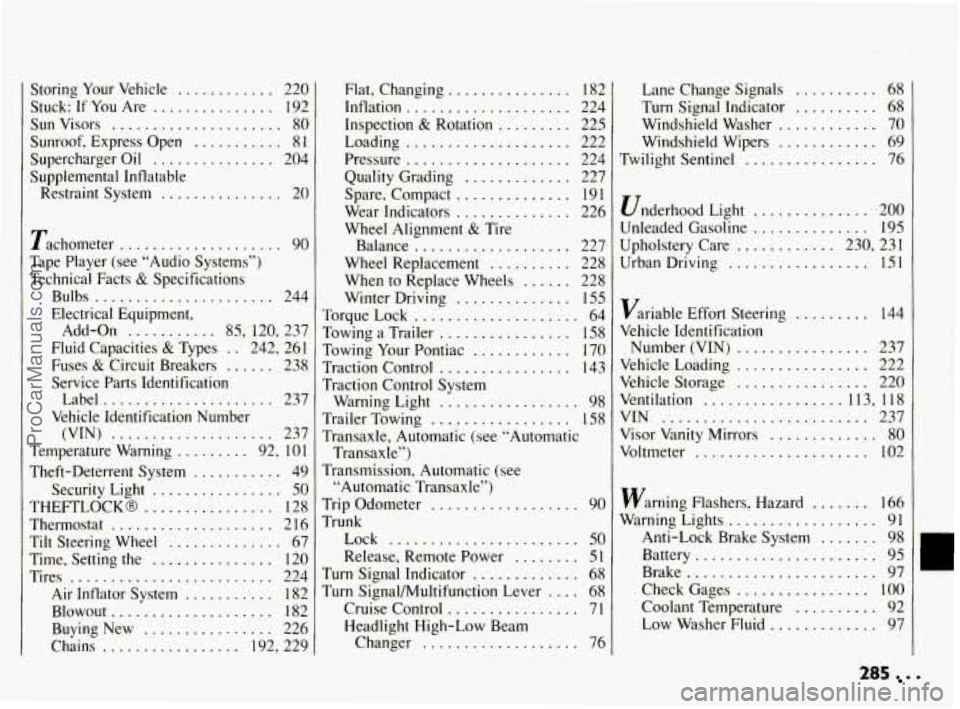
Storing Your Vehicle ............ 220
Stuck:
If You Are ............... 192
Sun Visors
..................... 80
Sunroof. Express Open
........... 81
Supercharger Oil
............... 204
Restraint System
............... 20
Supplemental Inflatable
Tachometer
.................... 90
Tape Player (see “Audio Systems”)
Technical Facts
& Specifications
Bulbs
...................... 244
Electrical Equipment. Add-on
........... 85. 120. 237
Fluid Capacities
& Types . . 242. 261
Fuses
& Circuit Breakers ....... 2.28,
Service Parts Identification Label
..................... 237
Vehicle Identification Number
(VIN) .................... 237
Temperature Warning
......... 92. 101
Theft-Deterrent System ........... 49
Security Light
................ 50
THEFTLOCKB
................ 128
Thermostat
.................... 216
Tilt Steering Wheel
.............. 67
Time. Setting the
............... 120
Tires
......................... 224
Air Inflator System ........... 182
Blowout
.................... 182
Buying New
................ 226
Chains
................. 192. 229 Flat. Changing
............... 182
Inflation
.................... 224
Inspection
& Rotation ......... 225
Loading
.................... 222
Pressure
.................... 224
Quality Grading
............. 227
Spare. Compact
.............. 19 1
Wear Indicators .............. 226
Wheel Alignment
& Tire
Wheel Replacement
.......... 228
When to Replace Wheels
...... 228
Winter Driving
.............. 155
Balance
..................... 227
Torque Lock
.................... 64
Towing a Trailer ................ 158
Towing Your Pontiac
............ 170
Traction Control
................ 143
Traction Control System Warning Light
................. 98
Trailer Towing
................. 158
Transaxle. Automatic (see “Automatic
Transmission. Automatic (see
Transaxle”)
“Automatic Transaxle?’)
Trip Odometer
.................. 90
Trunk
Lock
....................... 50
Release. Remote Power ........ 51
Turn Signal/Multifunction Lever
.... 68
Cruise Control
................ 71
Headlight High-Low Beam
Turn Signal
Indicator
............. 68
Changer
................... 76 Lane Change
Signals
.......... 68
Turn Signal Indicator
.......... 68
Windshield Washer
............ 70
Windshield Wipers
............ 69
Twilight Sentinel ................ 76
Underhood Light
................ 200
Unleaded Gasoline
.............. 195
Upholstery Care
............ 230, 231
Urban Driving
................. 151
Variable Effort Steering
......... 144
Vehicle Identification Number (VIN)
................ 237
Vehicle Loading
................ 222
Vehicle Storage
................ 220
Ventilation 113.
118
VIN ......................... 237
.
.................
Visor Vanity Mirrors ............. 80
Voltmeter
..................... 102
Warning Flashers. Hazard
....... 166
Warning Lights .................. 91
Anti-Lock Brake System ....... 98
Battery
...................... 95
Brake ....................... 97
Check Gages
................ 100
Coolant Temperature
.......... 92
Low Washer Fluid ............. 97
285
ProCarManuals.com